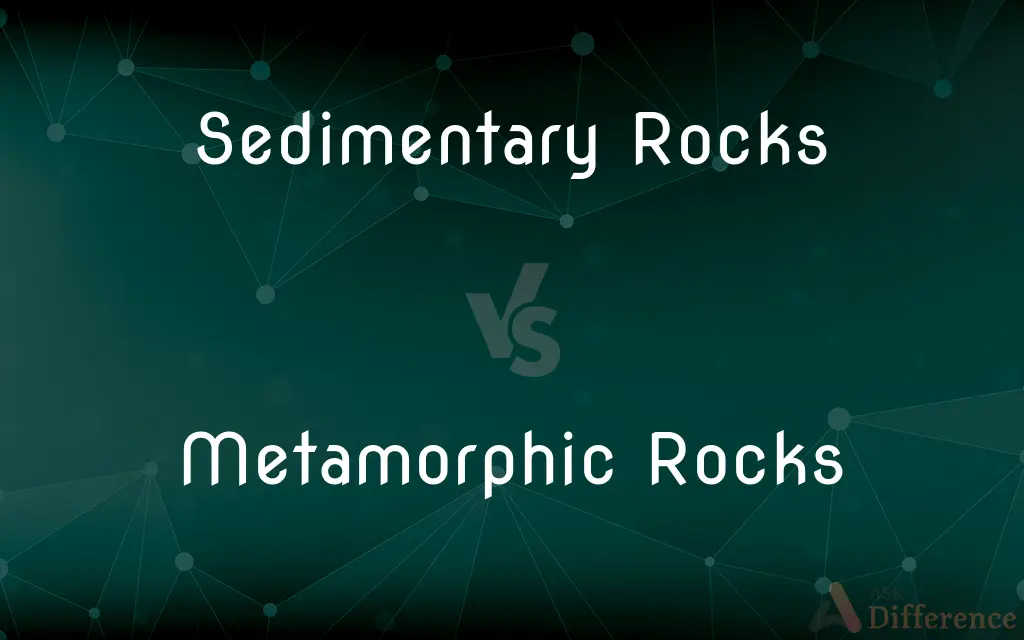Sedimentary Rocks vs. Metamorphic Rocks — What's the Difference?
By Tayyaba Rehman — Published on January 29, 2024
Sedimentary rocks form from accumulated sediment layers, often containing fossils, while metamorphic rocks are transformed by heat and pressure from existing rocks without melting.

Difference Between Sedimentary Rocks and Metamorphic Rocks
Table of Contents
ADVERTISEMENT
Key Differences
Sedimentary rocks are formed through the accumulation and compaction of sediments, such as sand, silt, and clay, often found in water bodies. Metamorphic rocks, conversely, are formed from existing rocks that undergo a transformation through heat and pressure, changing their mineral composition and structure.
Sedimentary rocks often have layered appearances and can contain fossils, providing clues to the Earth's history. Metamorphic rocks are characterized by a more crystalline structure and do not typically contain fossils, as the intense conditions of their formation would destroy any organic material.
The process of forming sedimentary rocks includes weathering, erosion, deposition, compaction, and cementation. Metamorphic rocks are formed through processes like recrystallization under conditions of high temperature and pressure, significantly altering their original form.
Common examples of sedimentary rocks include sandstone, shale, and limestone, which are frequently used in construction. Examples of metamorphic rocks include slate, marble, and schist, known for their strength and used in various architectural and artistic applications.
Sedimentary rocks are often softer and more porous compared to metamorphic rocks, which are typically harder and more resistant due to the intense conditions they undergo during formation.
ADVERTISEMENT
Comparison Chart
Formation
Accumulation and compaction of sediments
Transformation from existing rocks by heat and pressure
Appearance
Often layered, may contain fossils
Crystalline, foliated or non-foliated texture, no fossils
Formation Process
Weathering, erosion, deposition, compaction, cementation
Recrystallization under high temperature and pressure
Common Examples
Sandstone, shale, limestone
Slate, marble, schist
Characteristics
Softer, porous
Harder, more resistant
Compare with Definitions
Sedimentary Rocks
Sedimentary rocks often contain fossils and are vital in studying Earth's history.
Fossilized remains found in sedimentary rocks help scientists understand ancient life.
Metamorphic Rocks
Characterized by foliated or non-foliated textures.
Slate, used in roofing, is a foliated metamorphic rock formed from shale.
Sedimentary Rocks
Includes rock types such as sandstone, shale, and limestone.
Sedimentary rocks such as limestone are often used in the construction industry.
Metamorphic Rocks
Includes rock types like slate, marble, and schist.
Marble, a metamorphic rock, is widely used in sculpture and architecture.
Sedimentary Rocks
Rocks formed by the deposition and cementation of sediment.
The Grand Canyon showcases layers of sedimentary rocks like shale and sandstone.
Metamorphic Rocks
These rocks do not contain fossils due to their formation process.
Gneiss, a common metamorphic rock, lacks any fossilized remains.
Sedimentary Rocks
These rocks are typically softer and can be eroded by water and wind.
Sedimentary rocks like limestone are commonly used in building materials.
Metamorphic Rocks
Rocks transformed from existing rock types through heat and pressure.
Marble, a metamorphic rock, is formed from limestone under extreme conditions.
Sedimentary Rocks
Formed in layers through processes like weathering and erosion.
The layered structure of sedimentary rocks is evident in cliff faces.
Metamorphic Rocks
Metamorphic rocks often have a crystalline structure due to recrystallization.
Schist, a type of metamorphic rock, is known for its distinct foliated texture.
Common Curiosities
Which rock type is more porous, sedimentary or metamorphic?
Sedimentary rocks are generally more porous.
Can sedimentary rocks contain fossils?
Yes, they often contain fossils, which provide insights into Earth's past.
Do metamorphic rocks have a layered appearance?
They can have a foliated (layered) or non-foliated texture.
Are sedimentary rocks important for geological studies?
Yes, they are crucial in understanding Earth's history and geologic events.
What is a key characteristic of metamorphic rocks?
They often have a crystalline structure due to recrystallization.
Is marble a sedimentary or metamorphic rock?
Marble is a metamorphic rock.
What causes the formation of metamorphic rocks?
The transformation of existing rocks under heat and pressure.
What are some common uses of sedimentary rocks?
They are widely used in construction and as building materials.
How are sedimentary rocks formed?
Through the deposition, compaction, and cementation of sediments.
Are metamorphic rocks typically harder than sedimentary rocks?
Yes, metamorphic rocks are generally harder due to their formation process.
How does weathering affect sedimentary rocks?
Weathering can erode sedimentary rocks, forming new sediments.
What role do sedimentary rocks play in the carbon cycle?
They often store carbon and play a role in the Earth's carbon cycle.
Can metamorphic rocks form from sedimentary rocks?
Yes, sedimentary rocks can transform into metamorphic rocks under certain conditions.
What is an example of a sedimentary rock?
Limestone is a common example of a sedimentary rock.
Can metamorphic rocks be used in construction?
Yes, some, like marble and slate, are used in construction and decoration.
Share Your Discovery

Previous Comparison
Cayenne Pepper vs. Chili Powder
Next Comparison
Cello vs. Double BassAuthor Spotlight
Written by
Tayyaba RehmanTayyaba Rehman is a distinguished writer, currently serving as a primary contributor to askdifference.com. As a researcher in semantics and etymology, Tayyaba's passion for the complexity of languages and their distinctions has found a perfect home on the platform. Tayyaba delves into the intricacies of language, distinguishing between commonly confused words and phrases, thereby providing clarity for readers worldwide.














































